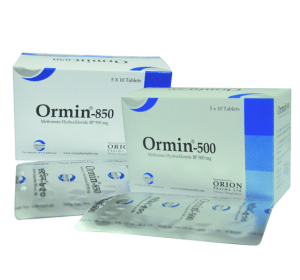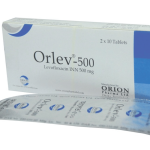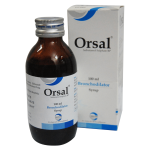Ormin

ANTIDIABETICS: Metformin Hydrochloride
Indication
In NIDDM (Non-insulin dependent diabetes mellitus or type-2 diabetes): As monotherapy, as an adjunct to diet to lower blood glucose in patients with NIDDM whose hyperglycemia can not be satisfactorily managed on diet alone. Ormin (Metformin Hydrochloride) may be used concomitantly with a sulphonylurea when diet and metformin or sulphonylurea alone do not result in adequate glycemic control.
In IDDM: As an adjunct therapy in combination with insulin.
Contraindication
Ormin (Metformin Hydrochloride) is contraindicated in
- Renal disease or dysfunction which may also result from conditions such as cardiovascular collapse (shock), acute MI & septicemia.
- Patients undergoing radiologic studies involving parenteral administration of iodinated contrast meals.
- Hypersensitivity to Ormin (Metformin Hydrochloride).
- Acute or chronic metabolic acidosis including diabetic ketoacidosis with or without coma.
Dosage & Administration
There is no fixed dosage regimen for the management of hyperglycemia in diabetes mellitus with Ormin (Metformin Hydrochloride). Dosage must be individualized on the basis of both effectiveness and tolerance while not exceeding the maximum recommended daily dose of 2550 mg.
Ormin (Metformin Hydrochloride) 500 mg: The usual starting dose is one 500 mg tablet twice daily, given with the morning or evening meals. Dosage increase should be made in increments of 500 mg every week, given in divided dose, up to a maximum of 2550 mg/day. Metformin can be administered twice a day up to 2000 mg/day (e.g. 1000 mg twice daily with morning & evening meals). If a 2500 mg daily dose is required, it may be better tolerated given three times daily with meals.
Ormin (Metformin Hydrochloride) 850 mg: The usual starting dose is one 850 mg tablet daily given with the morning meals. Dosage increases should be made in increments of 850 mg every other week, given in divided doses, up to a maximum of 2550 mg/day. The usual maintenance dose is 850 mg twice daily with the morning and evening meals. When necessary, patients may be given 850 mg 3 times daily with meals.
Or as directed by the physicians.
Side Effect
Lactic acidosis is a rare but serious metabolic complication that can occur due to metformin accumulation during treatment. Adverese reactions occurring in 3% of patients include diarrhea, nausea, vomiting, abdominal bloating, flatulence, anorexia, an unpleasant metallic taste, asymptomatic subnormal serum vitamin B12 levels.
Drug Interaction
Drugs that may affect Ormin (Metformin Hydrochloride) include Alcohol, cationic drugs, Cimetidine, Furosemide, Iodinated contrast material and Nifedipine. Drugs that may be affected by Ormin (Metformin Hydrochloride) include Glyburide and Furosemide. Certain drugs tend to produce hyperglycemia and may lead to loss fo glycemic control such as Thiazide and other diuretics, corticosteroids, phenothiazines thyroid products, estrogens, oral contraceptives, Phenytoin, Nicotinic acid, Sympathomimetics, Calcium channel blockers, Isoniazide and Beta adrenergic blockers.
Presentation
Ormin 500: Box containing 5X10 tablets in blister pack.
Ormin 850: Box containing 5X10 tablets in blister pack.



